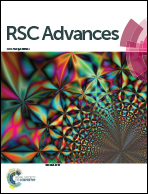Effect of the MWCNTs selective localization on the dielectric properties for PVDF/PS/HDPE ternary blends with in situ formed core–shell structure
Abstract
This work demonstrated the selective localization of multiwall carbon nanotubes (MWCNTs) in (70/20/10 vol%) poly(vinylidene fluoride) (PVDF)/poly(styrene) (PS)/high-density poly(ethylene) (HDPE) ternary blends to be an effective method to reduce the dielectric loss and maintain high dielectric constant simultaneously. Here, PVDF/PS/HDPE blends displayed a core–shell structure, HDPE phase was the core and PS phase was the shell. When MWCNTs was added into PVDF/PS/HDPE blends, it stably dispersed in the PS layer. The morphology, electrical properties, and dielectric properties of (PVDF/PS/HDPE)/MWCNTs composites were investigated. The results indicated that the conductivity as well as the dielectric permittivity value increased with the content of MWCNTs. Meanwhile, the dielectric permittivity was dependent on the electric field frequency. The dielectric constant for (PVDF/PS/HDPE)/MWCNTs composites was 400 with 1.0 vol% MWCNTs at 102 Hz, accompanied by a low dielectric loss of 10 which was about 400 times lower than that of PVDF/MWCNTs composites. Therefore, a low dielectric loss and high dielectric constant for (PVDF/PS/HDPE)/MWCNTs composites, which formed a core–shell structure, have been obtained through MWCNTs selectively locating in PS shell even at high contents of MWCNTs.


 Please wait while we load your content...
Please wait while we load your content...